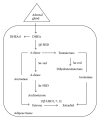Sex hormone receptor repertoire in breast cancer
- PMID: 24324894
- PMCID: PMC3845405
- DOI: 10.1155/2013/284036
Sex hormone receptor repertoire in breast cancer
Abstract
Classification of breast cancer as endocrine sensitive, hormone dependent, or estrogen receptor (ER) positive refers singularly to ER α . One of the oldest recognized tumor targets, disruption of ER α -mediated signaling, is believed to be the mechanistic mode of action for all hormonal interventions used in treating this disease. Whereas ER α is widely accepted as the single most important predictive factor (for response to endocrine therapy), the presence of the receptor in tumor cells is also of prognostic value. Even though the clinical relevance of the two other sex hormone receptors, namely, ER β and the androgen receptor remains unclear, two discordant phenomena observed in hormone-dependent breast cancers could be causally related to ER β -mediated effects and androgenic actions. Nonetheless, our understanding of regulatory molecules and resistance mechanisms remains incomplete, further compromising our ability to develop novel therapeutic strategies that could improve disease outcomes. This review focuses on the receptor-mediated actions of the sex hormones in breast cancer.
Figures





Similar articles
-
Keratinocyte growth factor (KGF) induces tamoxifen (Tam) resistance in human breast cancer MCF-7 cells.Anticancer Res. 2006 May-Jun;26(3A):1773-84. Anticancer Res. 2006. PMID: 16827106
-
Patient-derived luminal breast cancer xenografts retain hormone receptor heterogeneity and help define unique estrogen-dependent gene signatures.Breast Cancer Res Treat. 2012 Sep;135(2):415-32. doi: 10.1007/s10549-012-2164-8. Epub 2012 Jul 24. Breast Cancer Res Treat. 2012. PMID: 22821401 Free PMC article.
-
Phosphorylation of estrogen receptor alpha serine 167 is predictive of response to endocrine therapy and increases postrelapse survival in metastatic breast cancer.Breast Cancer Res. 2005;7(5):R753-64. doi: 10.1186/bcr1285. Epub 2005 Jul 27. Breast Cancer Res. 2005. PMID: 16168121 Free PMC article.
-
Oestrogen receptors in breast cancer: basic mechanisms and clinical implications.Ecancermedicalscience. 2013 Nov 5;7:370. doi: 10.3332/ecancer.2013.370. Ecancermedicalscience. 2013. PMID: 24222786 Free PMC article. Review.
-
Endocrine therapy and strategies to overcome therapeutic resistance in breast cancer.Curr Probl Cancer. 2016 Mar-Aug;40(2-4):95-105. doi: 10.1016/j.currproblcancer.2016.09.001. Epub 2016 Sep 17. Curr Probl Cancer. 2016. PMID: 27839747 Review.
Cited by
-
Lost but Not Least-Novel Insights into Progesterone Receptor Loss in Estrogen Receptor-Positive Breast Cancer.Cancers (Basel). 2021 Sep 23;13(19):4755. doi: 10.3390/cancers13194755. Cancers (Basel). 2021. PMID: 34638241 Free PMC article. Review.
-
MiR-942-3p as a Potential Prognostic Marker of Gastric Cancer Associated with AR and MAPK/ERK Signaling Pathway.Curr Issues Mol Biol. 2022 Aug 24;44(9):3835-3848. doi: 10.3390/cimb44090263. Curr Issues Mol Biol. 2022. PMID: 36135175 Free PMC article.
-
Research progress on estrogen receptor-positive/progesterone receptor-negative breast cancer.Transl Oncol. 2025 Jun;56:102387. doi: 10.1016/j.tranon.2025.102387. Epub 2025 Apr 14. Transl Oncol. 2025. PMID: 40222338 Free PMC article. Review.
-
Influence of Androgen Receptor Expression on the Survival Outcomes in Breast Cancer: A Meta-Analysis.J Breast Cancer. 2015 Jun;18(2):134-42. doi: 10.4048/jbc.2015.18.2.134. Epub 2015 Jun 26. J Breast Cancer. 2015. PMID: 26155289 Free PMC article.
-
Nuclear receptors and pathogenesis of pancreatic cancer.World J Gastroenterol. 2014 Sep 14;20(34):12062-81. doi: 10.3748/wjg.v20.i34.12062. World J Gastroenterol. 2014. PMID: 25232244 Free PMC article. Review.
References
-
- Boyd S. On oophorectomy in cancer of the breast. British Medical Journal. 1900;2:1161–1167.
-
- Jensen VE, Jacobson IH, Walf AA, Frye AC. Basic guides to the mechanism of estrogen action. Recent Progress in Hormone Research. 1962;18:318–414.
-
- Fisher B, Redmond C, Fisher ER, Caplan R. Relative worth of estrogen or progesterone receptor and pathologic characteristics of differentiation as indicators of prognosis in node negative breast cancer patients: findings from national surgical adjuvant breast and bowel project protocol B-06. Journal of Clinical Oncology. 1988;6(7):1076–1087. - PubMed
Publication types
LinkOut - more resources
Full Text Sources
Other Literature Sources

